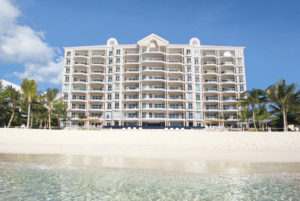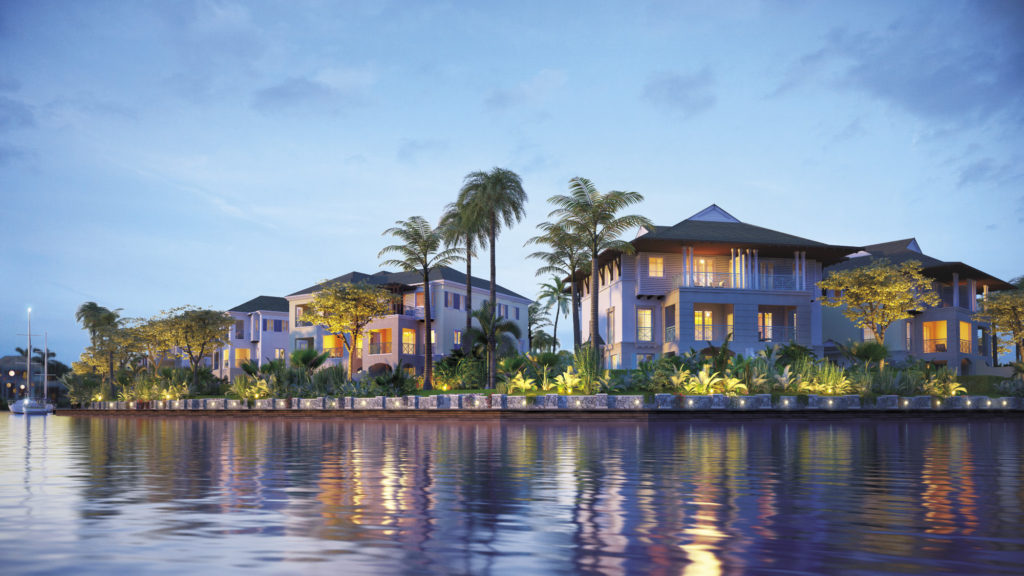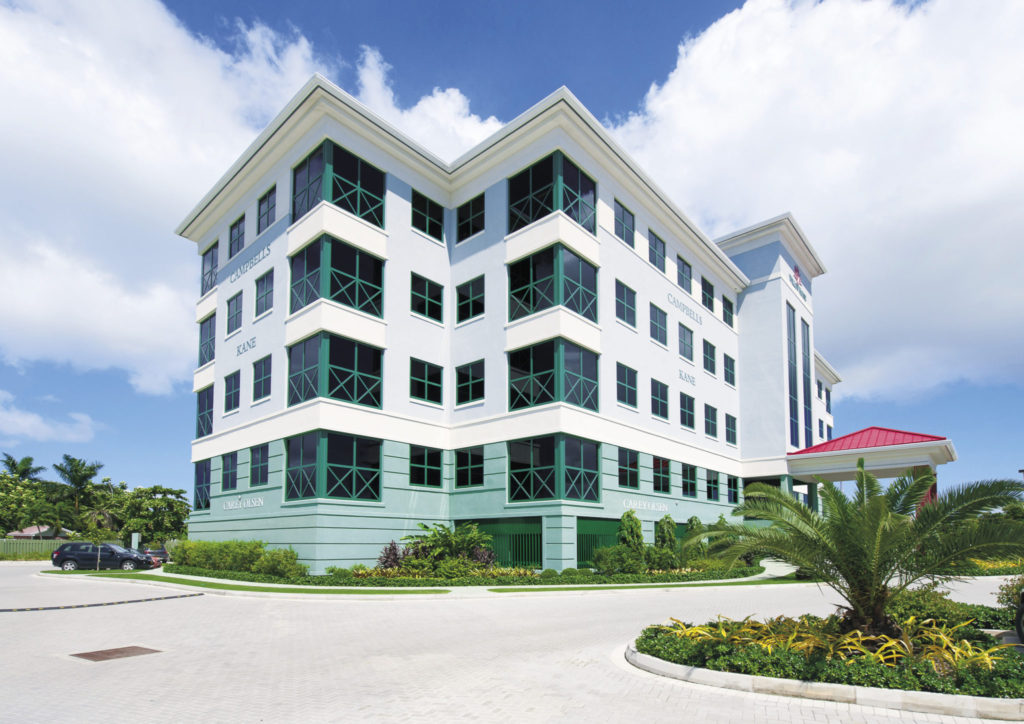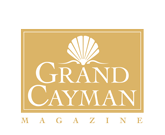A rebounding economy is sparking muscular returns in the Cayman real estate market, driving both prices and volume to record highs and sparking a frenzy of residential development, particularly in the South Sound area.
Seven Mile Beach’s premier condo development, The WaterColours, which opened in 2014, is selling nicely with only six units remaining of the original 60 residences, sized from three-bedrooms to six bedrooms, from 3,600 square feet to more than 7,000 square feet, and priced upwards of $3.5 million.

Also on Seven Mile Beach, the Ritz-Carlton, Grand Cayman has completed work on five residences at 7 South, selling upwards of $1,500 per square foot, fully $300-up-to-$800 per square foot more than previous standards. The last sale was in December, a US$3.35 million three-bedroom residence that sold at US$1,041 per square foot.
Down the road, multi-million-dollar renovations have started on the old Treasure Island Resort, renamed Margaritaville Beach Resort after November’s $15.5 million purchase by Miami’s Howard Hotel Group.
Scheduled for a December opening this year, the Seven Mile Beach landmark will feature 280 guest rooms and 110 condominiums, bars, restaurants, and two swimming pools.
Perched on a private peninsula on North Sound near the Cayman Islands Yacht Club, the latest development is 44 three-storey residences at the $110 million Stone Island, poised to break ground later this year.

Near to the Yacht Club, and close by West Bay’s prestigious Boggy Sand Road, is Boggy Sands development, 20 three-bedroom 2,400-square-foot condominiums with a clubhouse and two swimming pools on 2.4 acres. Priced between $885,000 and $1 million, construction started on May 1 last year, with Phase 1 now completed. Developers Coen Coleman Ltd say only eight units remain.
Rounding out the list in the West Bay area are the 62 homes in the 10-story tower at the Kimpton Seafire. Sales are brisk notwithstanding a record $1,700 per square foot, according to brokers, pegging costs between $1 million and $8 million for a unit.
According to David Seerman, vice president of sales for hotel owner Dart Realty, the residences “will welcome owners in early 2017,” immediately after the hotel opens in November 2016.
“The Residences at Seafire offer 62 diverse floorplans from studios to four-bedrooms,” Seerman says. “The innovative design, which features an open floor plan concept, makes it possible for almost all bedrooms to have a water view of Seven Mile Beach or the North Sound. Many of the residences have sea-to-sea views.”
While he declined to comment directly on square-foot costs for the residences, Seerman said Dart had “invested significant resources” in its first hotel and first for-sale residential project, saying “we have received reservations at record square foot costs for Seven Mile Beach properties.”
According to Re/Max founder and broker Kim Lund, the Kimpton “is a whole new pricing paradigm.” He points to more expensive construction costs, relatively limited supply balanced against growing demand, a desire for healthy profits by developers and a willingness on the part of a younger breed of investors to pay top dollar.
“Levels of supply are plummeting, are condominiums along … Seven Mile Beach … are now flying out of the door,” according to Bould Consulting’s Valuation Newsletter. Dated “Summer 2015,” the document nonetheless indicates sustained market conditions.
“The upsurge in demand has now seen values rise … It’s now a sellers’ market and the asking price for the few units available certainly reflects this,” the newsletter says.
Bould also points to both Crystal Harbour and Governor’s Harbour, where canal-front prices have surged “up to 35 percent in the past year.

“There are now very few opportunities to purchase land in the Seven Mile Beach corridor,” while “off-market” deals “are increasingly being conducted without the need even to advertise,” according to the valuation firm.
“There’s a lot of confidence,” said International Realty Group founder Jeremy Hurst, pointing, like Lund and Bould, to a sense of burgeoning development.
“The private sector and government are working toward economic recovery. Health City is expanding medical tourism, which is bringing confidence to the country that we are not reliant on one or two sectors.
“Cayman Enterprise City will bring other investors. Neither of these has reached its potential,” he says, but both are fueling a buoyant market.
East End’s Health City has announced a 2016 $25 million capital investment program, with another several million dollars of private investment – a commercial center and hotel – nearby. The hospital’s April accreditation last year by the U.S. Joint Commission International has cleared the path for international patient traffic to begin in earnest.
The enormous mixed-used special economic zone, Cayman Enterprise City, is also set to break ground in 2016 near Fairbank’s Road with links to South Sound.
Cindy O’Hara, chief development officer for CEC, said the group planned groundbreaking “in Q3 or Q4,” on the first of two $25 million gateway buildings in phase one, which will ultimately comprise six structures. Enterprise City’s 20-year build-out will cover between 800,000 square feet and 850,000 square feet, gathered around a 10-acre artificial lake.
CEC already has overall Planned Area Development permission for the 70-acre site, and officials are working on gaining approvals for its subdivisions.
“It’s flexible,” O’Hara says, describing the possible scale of the development: “If, let’s say, a university wanted housing, we could do that. There will be limited retail; it’s more like a campus-style development.”
In fact, CEC planners have already spoken of a possible hotel and low-density residential housing, developed in later phases, driven by demand.
The main entrance – the first of several – will be off Fairbanks Road,” near the women’s prison, O’Hara said, “and we’ll need a road system in there. There will be roundabouts and connectors in there; some will have to be added to the gazette.”
The site, 1,000 feet wide and 3,000 feet long, will connect to an NRA extension of the East-West Arterial with connections to Fairbanks Road, and an extension of Agnes Way across an expanded Linford Pierson Highway.
Expanding the East-West Arterial, Linford Pierson, Agnes Way and even Crewe Road will not only ease rush-hour traffic in and out of George Town, but also will allay worries that the South Sound boom might overwhelm the humble two-lane blacktop that is South Sound Road.
That boom has brought near-frenetic development to the previously sleepy area: Stefan Baraud’s six-condominium Shore Club is sold out; Davenport Development’s 56-condo Vela Phase I is also sold out, while Phase II’s 56 condos are half gone, and Phase III’s 56 more condos are in planning.
Naul Bodden has already sold eight of his 24 residences at Tides, a 1.6-acre beachfront development near the South Sound Cemetery. Groundbreaking is in June with completion scheduled for September 2017.
Rene Hislop is selling a nine-acre development site next to the 40 acres already sold to China’s Datang Investments for 30 condos and a shopping center. The builders are contemplating Phase II.
The developments involve road infrastructure, and planners at the National Roads Authority also point to the 91-acre Adagio Community Development residential site west of Old Crewe Road, comprising 20 lots for “multi-family dwelling units,” and a residential development of eight multi-family units on Bel Air Drive.
Hurst says sales figures are powerful and climbing.
“Basically, we’re seeing growth of 11 percent in property transfers in 2014-2015, a volume of CI$600 million,” he says, outpacing the 2008 high of $560 million.
“In 2010,” he said, during the depths of the global recession, “that dropped to $300 million, but now “we have recovered,” he declares.
Hurst is quick to point out that while 2011’s $632 million in property transfers/sales volume appears to have outpaced all other years, a one-off event pushed that number.
“The 2011 figures were skewed upwards by the sale of the Stan Thomas’ properties to Dart,” he says – the old Marriott Courtyard – now rebuilt on 12 acres as the Kimpton Seafire – and properties in and around Salt Creek north of the hotel.
The volume is set to drive the entire economy after four-year doldrums. Coldwell Banker broker/owner J.C. Calhoun says the sense of relief – after a long period of tightened belts — is almost palpable.
“People are even buying raw land again just because the market has improved,” he said. “Local people have some money now,” and residential purchases are driving restaurants, furniture stores, restaurant suppliers, taxi drivers. It takes a year or two of tourist-related income to give local people the opportunity to take a loan, buy a car, upgrade their home, get some appliances, and it’s all starting to happen now.”
Tourist-arrival numbers underline Calhoun’s point.
The 2015 total for cruise ship tourists, who each spend approximately $100 per day, was 1.716 million, nicely outpacing last year’s 1.609 million, itself the highest since 2007’s prerecession 1.715 million, a tick less than last year, although not as high as 2006’s record 1.9 million.
Air arrivals, who use hotels, patronize restaurants, rent cars, and ultimately buy properties, hit a 15-year high of 385,378 in 2015. The next closest was 2014’s 382,816, the highest since 2000’s 354,087.
“We’ve seen a lot of people, mostly from the U.S., North America in general, and they are surprised. Prices here are now higher than in, say, Florida or even Austin, Texas,” says Lund.
More than 75 percent of 2015 air arrivals, almost 292,000, were from the US; 24,300, 6.3 percent, were from Canada; and 8.9 percent, nearly 34,300, were from Europe. The balance, roughly 9 percent, 35,028, were from “elsewhere.”
“The U.S. has a huge impact, especially in Seven Mile Beach, and new people are coming in, renting, and buying,” Lund says, and we get the benefit of them seeing the amount of works, the progress being made here, a lot of new developments – the port, the airport, downtown.”
The port and downtown are in early planning stages, so changes remain pending, but the sense of movement is infectious, Lund says.
“The feeling, then, is ‘we can wait’ or ‘we can do it now’ and most of the smarter people know that the longer they wait, things get more expensive,” so they are buying now.
“We are only starting to see price appreciation, just on the wholesale or larger level.”
Meanwhile, Calhoun laments a dramatically diminished inventory of South Sound residential units priced between $500,000 and $1 million, selling only three, in the area in the last four months. He knows of only one more remaining.
“South Sound is on fire. They are more in the nature of residences than rentals,” he says, pointing to older developments like Seaview and Oceana, on the northern part of South Sound Road and nearer to downtown, and running $1.5 million and up.
“Down South Sound and ‘around the corner’ are Bela and other stuff, across the street from the beach, with new granite and all the bells and whistles,” Calhoun says. “They are the equivalent of what used to be the average two-bedroom unit on Seven Mile Beach.”
“The coastline is a popular location,” Hurst says, with some understatement, “and you don’t necessarily need to be right on the water.”
Lund declares that “everything is up, a plus for Cayman. Everyone, including investors, see infrastructure improving, and South Sound is a rising tide, floating everyone’s boats, lifting everyone.”
The area, Lund says, represents “great value,” mostly, he said, “condominiums and apartments,” which numbers “run into the hundreds.”
The National Roads Authority says it is aware of the situation, but will not start work for some time yet, saying it will create temporary fixes and interim traffic-management techniques until a long-gazetted alternative to South Sound Road becomes a “national priority.”
“We do have plans for what is happening in South Sound, and we are in the planning stages for the roads,” according to NRA Senior Engineer Edison Jackson. “Right now, we are looking at the Linford Pierson Bypass,” expanding it to four lanes, but the highway and South Sound Road, he said, will ultimately intersect near CEC.
Gazetted long ago and informally dubbed “section 25,” the CEC corridor “has a lot of engineering work to be done,” Jackson said, assessing drainage, culverts, elevation, intersections, roundabouts, which all have to be completed “before full phasing.”
He was unable to say when work on the corridor might start: “We plan things a ways ahead, but it depends on CEC – and then we kick start [construction] as a national priority.”
In the meantime, small “fixes” will be implemented, smoothing access and traffic flows at various points. “We will do some engineering surveying of the road and see we can add some measures in the interim,” he said.
NRA Managing Director Paul Parchment said demand on the 15,000-foot road had grown nearly 66 percent since 2009, from 6,000 vehicles per day to 9,950 in 2015 in the vicinity of Crewe Road. Growth had been slower in the vicinity of Walkers Road, only 43 percent since 2009, registering 8,600 trips per day.
The congestion, he said, was because of rush-hour traffic between George Town and Red Bay, Prospect, Spotts, Savanah, and points east. South Sound Road was never “intended as a primary arterial roadway to move traffic to and from the schools and central business district.
“Approximately 30 percent of the traffic … is pass-through traffic as a consequence of lack of capacity on Linford Pierson and Crewe Road.”
Paul Pearson, half of the executive team at Davenport Development, said the population of his Vela phases I, II, and III “could be 300 people,” but doesn’t worry about the road infrastructure.
“The NRA does all the calculations, and you have to go to them for planning permission.” He and partner Ken Thompson had to give the NRA 50 feet of their Vela property, another 50 feet at their San Sebastian property while their neighbors had to give up a similar 50 feet “for the NRA bypass,” he said, while gated communities must set entrances as much as six car lengths back from the road, preventing any tailbacks from blocking the road.
“I live on South Sound, and have been there for years,” Pearson said, “and, no, I haven’t had problems. A lot of people thought San Sebastian would add so much more traffic to the road. It hasn’t.”
Matthew Wight, managing director for Naul Bodden’s NCB Group and its Tides development, says road congestion will not be an issue: “I don’t see it as a big problem at the moment. A lot the congestion in South Sound is not because of development but because of people using it as a passage from the Eastern Districts into George Town.”
However, a Jan. 10 objection to the Tides project filed with the Planning Department from an area resident argued the opposite: “The road infrastructure is not sufficient to house a 24-unit apartment complex,” the writer said. “[A]t this particular location, traffic in this area is already high.”
Wight answered the charge: “It would only be a problem if government did not keep its commitments to widen those roads.”
Baraud said he had to pay “a hefty infrastructure fee” to gain planning permission for his “ultra-high-end,” six-condo 16,800 square foot Shore Club, scheduled for a September opening.
The payment will help fund the new South Sound Bypass: “It is part of the CEC deal, and will take off a lot of the congestion. It’s getting closer; a lot is progressing and a lot is happening.
“That whole area has changed dramatically in the last 12 months,” he said, “and in another year or two it’s going to be very different again. I was driven by a vision of what South Sound had, a certain quiet charm, but now we will see.”
Calhoun predicts South Sound development will inevitably start “pushing out” into the Eastern Districts – including Ironwood and Dart’s Barefoot Beach.
“There’s been a lot of buzz that will push it further afield,” he says. “We have older customers who want to know, for example, how good our medical facilities are. That is a hot button for them, and the fact that the [facilities] are world-class does no harm. Even if they are as much as an hour away, it’s all right. It’s the knowledge they are there.”
Inland development is a distinct market from coastline real estate, he says, touching on St. James Point at Beach Bay, and says land sales are moving in Frank Sound and East End, and near the beaches at Cayman Kai: “There is a lot more interest in buying land, which ultimately will be used for single-family dwellings.”
Hurst says Beach Bay is shaping up to be a significant attraction: “The architectural – with high ceilings – is highly stylized, a whole new dimension, unlike anything we have seen in the Caribbean.”
Its 93 residences will attract a “younger set of investors,” ready to pay anything from $1 million up to $3 million.
Elsewhere in the interior, Calhoun says, price increases have not yet mirrored coastal areas: “It’s the only area lagging,” he says, explaining that it was overbuilt and over-financed as long ago as Hurricane Ivan, resulting in a “fairly substantial number of properties in forced sales,” as owners default on bank loans, a hangover from the recession.
He estimates 200 properties, 12 percent of CIREBA listings, are currently listed as “forced sales,” and names locations like Patrick’s Island, West Bay, Savannah and Prospect, “anything not on the water.”
Bould Consulting, regulated by The Royal Institute of Chartered Surveyors, adds Lower Valley and Bodden Town – “which are experiencing very low demand and oversupply” – to the list: “In these locations, the average marketing period is in excess of 12 months.”
Properties in foreclosure, Bould says, “are generally soaking up any demand that exists,” if not actually driving it.
Calhoun, however, remains upbeat, saying Cayman’s general economic improvement means foreclosure properties “are now being absorbed more rapidly” than in the past two years.
“Based on increasing absorption rates, it may be less than a year before we see price appreciation in the better inland properties,” he said.
Lund expects to see movement, albeit slowly, in the Eastern Districts, near Health City and Frank Sound’s Ironwood development, which he describes as a “whole other area for residences and medical tourism,” although it will need another two years or three years to spark that market. “Expansion will be one phase after another, as demand dictates and one phase drives the next,” he says.
Commercial development, all three brokers agree, has been largely overtaken by Dart Enterprises, offering not just the Kimpton Seafire, but 18 Forum Lane; its adjacent sister building, tentatively dubbed 18 Forum Lane South, boasting a 20,000 square foot landscaped courtyard between the two.
“Commercial always follows residential,” Calhoun says, because, for starters, “without roads, you don’t get commercial.
“Commercial has started to show some improvement, but there is not much downtown, and it won’t improve until they fix it. A lot of improvements are needed: traffic and parking need to be addressed, but Camana Bay has already killed downtown George Town. They need another plan.”
He underscores the point, noting that energy costs in Camana Bay offices are half of those in older downtown buildings.
Hurst agrees that Dart has changed the commercial market entirely: “Dart has a different economic basis for its own development. They don’t need external financing.”
Elsewhere, he says, “the cruise dock has brought a little more certainty to downtown, but it’s too soon” to predict what may happen.
However, Hurst says, “Butterfield House was sold to a local law firm, and Mary Street’s Zephyr House has had lobby, reception-area, and external renovations.”

Cricket Square has gained permission for phase five, a $20 million, six-story, 120,000 square foot office building with parking for nearly 1,000 next to the Shedden Road Rubis station. Opening is expected in 2018.
Like his “one phase drives the next” prediction for the Eastern Districts, Lund observes that “in the next five years, you are going to see more and greater changes in Cayman than you have seen in the last 10 years and 20 years, and that will create a lot more attention and interest in Cayman, more tourism and more residential.
“It will be a huge difference, and it’s already started. Not many have noticed it just yet.”


















